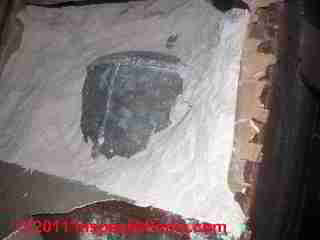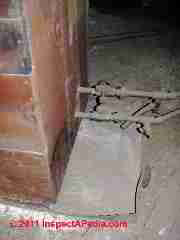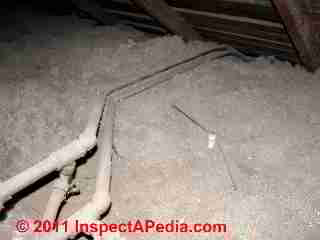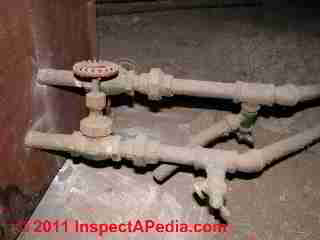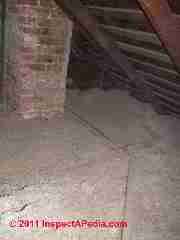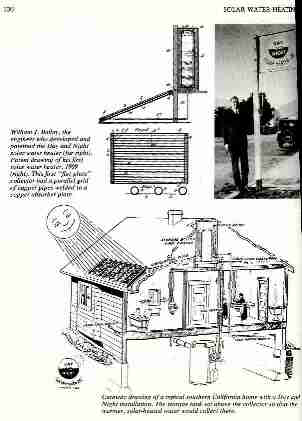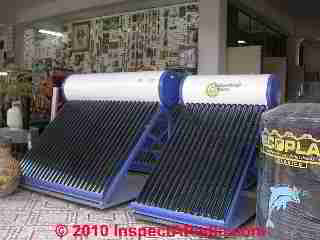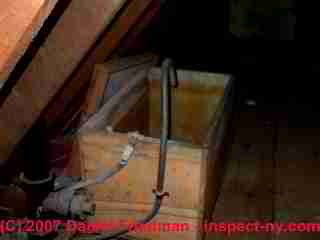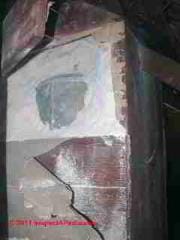 Antique Attic Water Storage Tanks vs. Antique Solar Water Heaters
Antique Attic Water Storage Tanks vs. Antique Solar Water Heaters
How to identify an attic-located hot water tank & its components
- POST a QUESTION or COMMENT about antique and modern solar hot water supply systems in buildings
Early solar water heaters for making domestic hot water:
In this article we describe an asbestos-insulated attic-mounted tank ultimately identified as a hot water storage tank almost certainly connected to a Day and Night Solar Water Heater or similar early solar hot water system that was widely used in California in the early 1900's.
We provide photos, clue-lists, piping diagrams and sketches as well as text to help identify the types of tanks found inside old buildings.
InspectAPedia tolerates no conflicts of interest. We have no relationship with advertisers, products, or services discussed at this website.
- Daniel Friedman, Publisher/Editor/Author - See WHO ARE WE?
attic-Mounted Solar Water Heater Tanks & Hot Water Storage Tank Identification
Photos, Pipes, Insulation, & Measurements Help Identify a Large, Antique, Insulated Steel Tank Found in an Attic: a Solar Water Heater or an Attic Cistern - water storage tank
[Click to enlarge any image]
Reader Question: Can You Identify This Old Tank in the Attic of our 1917 Home?
My wife and I purchased our 1917 home in downtown Riverside, California in 1984. In a few more years this house will be 100 years old.
To celebrate its coming birthday, I have started working on a small book about the history of the house.
When we bought the house we were told we were only the third owners, and the women we bought the house from (in her nineties) had her daughter (in her seventies) sell it to us.
The daughter told us her parents lived in the house for over fifty years and that they had not really done much to the house over all those years.

A few weeks ago the grandchildren of the second owners (in the fifties) stopped by the house from out of town to look at their grandparent’s house, which they had many fond memories of, and we invited them in for a tour.
They are going to contribute stories and old photos for my project.
Now that I’m starting this history project, I want to try and solve the big mystery of identifying “what the THING in my attic is. Over the years I’ve asked a number of people: plumbers, insulating contractors, etc., but no one knows what it is, or what it was for.
It has baffled me for years. Whatever it is, I’m assuming it’s somehow part of the plumbing, but I could be wrong. The THING is a large wooden structure in the center of my attic right under the peak [photo above left] and goes from the attic floor all the way to the top of the roof.
The wooden structure sits on a metal trough with a 3 inch lip all the around the outside of the wooden structure, and on one side the trough protrudes out about one foot.
[See photo at above left]
Two pipes are coming from where the roof meets the attic floor ( they elbow down the top of a wall I guess and maybe go down
to my basement or maybe go to the water source, I really don’t know where it comes from ).
These two pipes come across the attic floor and go inside the wooden structure near the bottom.
[Photo, left depending on what is found below, these pipes probably were originally connected to a solar collector - Ed.]
Each pipe has a very old, round shutoff valve, and both pipes also have a hose bib. The valves and bib are located over the protruding trough. [Photo, above]
There are two very short, capped-off pipes on the opposite side, and a third pipe coming out has an elbow, then goes all the way to the sidewall of the attic and goes through to the outside about 10 inches and is not capped ( maybe like an overflow ).
On the side of the wooden structure, there are two pipes coming out and going to the corner of the attic where they go down.
This is near a brick chimney flue which is not for a fire place, but is a flue for the stove exhaust in the kitchen and the hot water heater in the basement.
Since I was taking photos of this THING, I decided to pry a couple of wooden boards off to see what was inside it. I took off a board near the top, and there was a heavy paper underneath.
I poked it and broke a small hole and some white powder came out. I started to pry off the board above and as I did, the whole paper tore and a lot of white powder pored out onto the floor.
This revealed the top of a galvanized cylinder tank. The tank is sitting in the middle of the structure, and has this white powder packed around it. The powder is very fine and similar to talcum powder. The tank is not open at he top, it is curved and sealed closed. The tank is about a foot in diameter.
I showed the photos to a man here in Riverside who is part of the "Old Riverside Foundation." He said he's been inside about 90% of the vintage homes in Riverside and surrounding communities and has only seen one other contraption in an attic like the one in my attic.
The other one is in a 1913 home, later purchased by William Boyd, the actor who played Hopalong Cassidy in the 1950's western television series. It is configured and constructed just like mine and the tank is packed in white powder just like mine.
However this man does not really know what the tank is or what it does, and has no clue what the powder is or what its purpose is.
Do you have any idea what this THING is or was? I believe it is still tied into my plumbing? Do you have any idea what kind of powder this is and what its purpose was? I did a quick research and I don’t believe the powder is white asbestos from the pictures I’ve seen on the internet, but I don't know that for sure.
Thank you some much for taking a look at this, C.J. & B.J., Riverside CA
Possible Identity & Original Use of Attic Tanks Found in Older Homes
Take a look at and record the information listed at IDENTIFY WATER TANK USE we describe how knowing the tank size, insulation (if any, location, and piping arrangement can help to identify the original use of a storage tank found in a building. You will see from the number of pipes connected to the storage tank illustraged above that it is some type of water storage tank, probably a solar hot water tank.
It looks from the partial exposure as if the tank is in a location where people used to put expansion tanks on hot water heating boilers - instead of a relief valve, if pressure in the system got too high, water would push into the tank and if the tank got too full, water would flow out of a drain into an outdoor location, sometimes even a roof gutter or downspout.
But this tank something else. An expansion tank has just one inlet pipe that feeds water from the hot water heating system, and for attic-located expansion tanks, an overflow drain line.
Because the tank in your photographs is insulated, it's not likely to be an expansion tank and probably not an attic cistern - people didn't usually bother to insulate those containers.
If I had to guess, I'd speculate that the tank in your photos it was used to store hot water.
And arguing in support of a hot water application is the observation that your tank has so many pipes connected to it - we have talked ourselves out of the expansion tank theory entirely.
A cold water storage tank such as an attic cistern typically has a single fill pipe entering the tank, a single building supply pipe exiting the tank to deliver water to building plumbing fixtures, and possibly a third overflow pipe to handle over-filling by directing it outdoors or to a drain.
A hot water tank such as a range boiler would have water coming in from a boiler or supply, water going out to plumbing, possibly heating by gravity or convection. More pipes and connections, a least five for an attic tank:
- Cold water supply into the water tank, coming from building water supply piping
- Hot water supply out of the water tank, connected to building hot water piping routed to sinks, tubs, etc.
- Cold water drain out of tank bottom that drops cold water down to a heating boiler or side-arm coil, or to a solar water heater where water from the tank is heated
- Hot water supply into the tank that feeds hot water, heated by the boiler or other heat source, perhaps by convection alone, back up into the hot water tank or range boiler
- An overflow pipe that drains to daylight and is used to prevent overpressure inside the tank may be present on an attic range boiler (or on an attic expansion tank).
See WATER HEATER PIPING for clues that can help explain what a tank was used for or how a solar water heater or other water heater system is installed and piped.
Also see Plumbing Connections for a Range Boiler above.
Control valves may have provided for manual filling or draining of the tank. One might try arguing that the insulation was to avoid freezing, but that wouldn't explain why you saw no insulation on the pipes connected to the tank - or was it drained in winter and the system left dry?
If the tank was intended to be drained at times, for service or freeze protection, that little hose and drain pan may have been there to permit leaving the drain line open and to catch the last few drips of water from inside the tank after it was drained through its drain line (over by the chimney perhaps).
Watch out for Possible Asbestos
Watch out: while using loose-fill asbestos in powdered form would be unusual as tank insulation, I'm worried that in the installation described above someone may have poured fill asbestos around that tank to serve as insulation. If the material is firm and foam-like and pale yellow, and collapses to powder on touch it may be UFFI and not so harmful. But if this is a white, loose, dry powder, watch out - seal it off with plastic until we know what you're dealing with. Hopefully it's something else.
Obtain advice from an expert, or in an emergency, clean up a tiny spill with a HEPA vacuum, and don't track this material through the house, or you may create a more costly cleanup job.
UFFI was blown in to building walls during the energy worries of the 1970's oil embargo. Your antique attic tank installation with the paper and pit-saw cut boards (FRAMING MATERIALS, AGE, TYPES) looks much older, probably from the time of original construction of the home back in 1917.
Guessing at the Original Use of An Attic-Mounted Hot Water Tank - Solar Water Heater Hot Water Storage?
A first guess considering size, location, and insulation is that the tank was for storing hot water from a boiler or some hot water source for example, feeding hot water down into the house by gravity and perhaps heating the water in the tank by natural convection to and from a basement boiler or even a separate water heater that could even have been down in the basement.
If you can give me tank dimensions (and don't have an asbestos problem) that'd be helpful.
We need to look more closely at where piping comes and goes.
Watch out: if the covering boards were removed (DONT MESS before we know the asbestos question) you'd find hat those four pipes are connected to different heights on the tank.
It's unusual in my experience to put a range boiler in an attic, so remote from the heating boiler, but someone may have done so thinking that they would get better hot water delivery pressure in the home.
And I'd like to know the full measurements of the tank or if you leave it boxed in pending the asbestos question, just the dimensions of the wooden framed box would help.
Keep me posted on the asbestos worry and about to where you can trace piping - that asbestos question is a priority concern.
Ultimately, with reader help we were able to identify the most likely purpose of the water storage tank described above. Key in understanding the tank's design and use was an examination of its piping connections.
Day and Night Solar Water Heater - early solar water heating design
Reader comment: If you can find a copy of the book A Golden Thread, it will help. I've attached a scan of a page that shows how the "Day and Night Solar Water Heater [Photo]" was installed.
Good chance that's what you have. Yours, Larry Weingarten - 8/20/2013
The text in Mr. Weingarten's attachment identifies what may indeed be the rest of the system that used the tank shown in the illustrations above. Larry can be reached through WaterHeaterRescue.com.
William J. Bailey, the engineer who developed and patented the Day and Night solar water heater ... [patented this design in 1909.] This first "flat-plate" [solar] collector had a parallel grid of copper pipes welded to a copper absorber plate. - [3] A Golden Thread ... 130.
At above-left we illustrate a modern solar water heater system widely used in Mexico and other sunny climates, and an obvious descendant of Bailey's Day and Night solar water heater.
Reader Follow-Up: Riverside CA tank was used for attic water storage, gypsum "insulation"
I have received information from historians here in Riverside who are aware of what my "mystery" plumbing tank in my attic is. It turns out there are 3 or 4 other older homes in Riverside that have the same plumbed tank in the attic. One of the houses is a famous house which was owned by the actor William Boyd who played Hopalond Cassidy on TV in the early fifties.
The Riverside historians explained that when my house was built in 1916, Riverside's municipal water district was brand new and water pressure was very unreliable. A handful of builders included an optional luxury for a few homes consisting of a water storage tank in the attic.
City water came into the house and went straight to the tank in the attic, filled the tank, then continued down to the bathrooms, kitchen and hose bibs. Then on days when the water pressure was bad or nonexistent, the water in the tank would gravity flow for normal continued use.
Also, I had the white powder packed around the tank tested and it wasn't asbestos, it was gypsum. Thanks for all the help and interest, C.J. - Riverside CA 10/8/2013
Reply: sorting out antique solar hot water from antique attic cold water storage
Wow, what good news, and thanks for the feedback;
I'll be sure to update the online information; Indeed while asbestos was widely used as an insulation material in buildings, in that use it was typically as asbestos paper, cloth, or lagging on pipe elbows; only in a few odd cases have we found loose asbestos insulation in homes - but it was indeed better to be safe than sorry, as such dust, had it been asbestos, could have led to a costly mess.
In fact the gypsum was perhaps considered also an insulating material, maybe to avoid condensation on the tank. So glad it worked out.
The general design of a backup water storage tank for use in areas where municipal water supply is inconsistent is indeed widespread and still common around the world.
You can see this in our rooftop water storage tanks (photo above) in wide use throughout Mexico, shown
What remains puzzling was what appeared in the photos to be more water pipes than would be needed for just an attic cistern. The multiple pipe connections along with the history of early solar water heaters in Riverside CA led me in the guess direction I described above.
Could you make a sketch for me of the pipes you observed connected to this device? Perhaps there were not as many connections as I first thought.
Also can we ge the dimensions of the tank; generally a cold water storage tank might be expected to be quite a bit larger than a hot water storage tank or water heater tank of any sort.
On the other hand, as I show at left, I have found an occasional very small attic "cistern" such as this one (above left) from a historic home in New England.
Research on Antique & Day-Night Solar Water Heaters
- [1] Bainbridge, David A. THE INTEGRAL PASSIVE SOLAR WATER HEATER BOOK [PDF] Solar Usage Now 104 (1981). Retrieved 8/21/2013 (online free PDF format) http://www.mangus.ro/pdf/Manual%20incalzire%20solara%20pasiva.pdf [large file 104pp]
- [2] Butti, Ken, and John Perlin. "Solar water heaters in California, 1891--1930." The Coevolution Quarterly;(United States) (1980). Abstract:
In Pasadena, California by 1897, 30% of the homes had solar water heaters. One manufacturer sold over 10,000 solar water heaters by the late 1920's. In 1891, Clarence M. Kemp patented the Climax solar water heater. By 1900, over 1600 of these systems were installed. Frank Walker, in 1898 improved the Climax design. Charles Hashell, by 1905 owned the rights of the Climax and Walker heaters.
William J. Bailey refined the Improved Climax by making it into two separate units-solar heat collector and hot water storage tank. He called the system the Day and Night Solar Heating System.
By the end of World War I, over 4,000 had been sold. In 1923 Bailey sold the rights on the heater. By 1941, at least 60,000 solar heaters were installed. When the war came, the government froze the use of copper bringing the solar industry to an abrupt halt. - [3] Butti, Ken, and John Perlin. A golden thread: 2500 years of solar architecture and technology. Vol. 514. Palo Alto, CA, USA: Cheshire books, 1980.
- [4] John Perlin & Amory Lovins, Let It Shine: The 6000-Year Story of Solar Energy, New World Library, Rev. 2013, ISBN-10: 1608681327, ISBN-13: 978-1608681327, Mr. Perlin can be reached at Tel: 805.569 2740, Email: jp@john-perlin.com, Website: john-perlin.com
- [5] Shukla, Anant, D. Buddhi, and R. L. Sawhney. "Solar water heaters with phase change material thermal energy storage medium: A review." Renewable and Sustainable Energy Reviews 13, no. 8 (2009): 2119-2125.
- Gehring, Kenneth C. WATER HEATING SYSTEM AND COMBINED STORAGE TANK AND HEAT EXCHANGER UNIT THEREFOR [PDF] U.S. Patent 4,148,355, issued April 10, 1979.
Abstract:
A combined storage tank and heat exchanger unit for heating water including a watertight tank having a water inlet in the lower portion thereof and a pair of water outlets in the upper portion thereof. The wall of the tank is in the form of a double wall jacket having a hot refrigerant inlet at the top portion thereof and a hot refrigerant outlet at the bottom portion thereof.
A cylindrical heat barrier is mounted inside the tank and spaced a short distance from the inside surface of the jacket wall to thermally isolate a relatively small amount of water in the tank in direct contact with the inner surface of the jacket.
A heat barrier disc is mounted in the tank and extends horizontally across the interior thereof to thermally isolate the water in the top portion of the tank from the water in the bottom portion thereof.
The water outlets communicate with the inte rior of the tank on opposite sides of the partition to provide heated water at two distinctly different temperatures.
An air passageway is provided between the outer surface of the jacket and the inner surface of the outer shell through which air is circulated to heat the room in which the unit is located. - [6] Gupta, C. L., and H. P. Garg. "System design in solar water heaters with natural circulation." Solar Energy 12, no. 2 (1968): 163-182.
- [7] Garg, H. P., and Usha Rani. "Theoretical and experimental studies on collector/storage type solar water heater." Solar Energy 29, no. 6 (1982): 467-478.
...
Continue reading at SOLAR HOT WATER HEATERS or select a topic from the closely-related articles below, or see the complete ARTICLE INDEX.
Or see these
Recommended Articles
- ALTERNATIVE HOT WATER SOURCES
- ATTIC & ANTIQUE EXPANSION TANKS, HEATING - other tanks found in attics
- EXPANSION TANKS
- IDENTIFY WATER TANK USE
- JETGLAS Day & Night WATER HEATERS - Day and Night Water Heaters, starting with Solar, invented by Bailey
- SOLAR ENERGY SYSTEMS
- SOLAR HOT WATER HEATERS
- SOLAR WATER HEATER ANTIQUE
- SOLAR HOT WATER HEATER TEMPERATURE CONTROL
- WATER HEATER PIPING
- WATER HEATER SAFETY
- WATER HEATER TEMPERATURE ADJUSTMENT CONTROLS
- WATER HEATERS - home
Suggested citation for this web page
SOLAR WATER HEATER ANTIQUE at InspectApedia.com - online encyclopedia of building & environmental inspection, testing, diagnosis, repair, & problem prevention advice.
Or see this
INDEX to RELATED ARTICLES: ARTICLE INDEX to SOLAR ENERGY
Or use the SEARCH BOX found below to Ask a Question or Search InspectApedia
Ask a Question or Search InspectApedia
Questions & answers or comments about installing, using, & repairing range boilers used for hot water supply in buildings.
Try the search box just below, or if you prefer, post a question or comment in the Comments box below and we will respond promptly.
Search the InspectApedia website
Note: appearance of your Comment below may be delayed: if your comment contains an image, photograph, web link, or text that looks to the software as if it might be a web link, your posting will appear after it has been approved by a moderator. Apologies for the delay.
Only one image can be added per comment but you can post as many comments, and therefore images, as you like.
You will not receive a notification when a response to your question has been posted.
Please bookmark this page to make it easy for you to check back for our response.
IF above you see "Comment Form is loading comments..." then COMMENT BOX - countable.ca / bawkbox.com IS NOT WORKING.
In any case you are welcome to send an email directly to us at InspectApedia.com at editor@inspectApedia.com
We'll reply to you directly. Please help us help you by noting, in your email, the URL of the InspectApedia page where you wanted to comment.
Citations & References
In addition to any citations in the article above, a full list is available on request.
- Mark Cramer Inspection Services Mark Cramer, Tampa Florida, Mr. Cramer is a past president of ASHI, the American Society of Home Inspectors and is a Florida home inspector and home inspection educator. Mr. Cramer serves on the ASHI Home Inspection Standards. Contact Mark Cramer at: 727-595-4211 mark@BestTampaInspector.com
- John Cranor [Website: /www.house-whisperer.com ] is an ASHI member and a home inspector (The House Whisperer) is located in Glen Allen, VA 23060. He is also a contributor to InspectApedia.com in several technical areas such as plumbing and appliances (dryer vents). Contact Mr. Cranor at 804-873-8534 or by Email: johncranor@verizon.net
- Our recommended books about building & mechanical systems design, inspection, problem diagnosis, and repair, and about indoor environment and IAQ testing, diagnosis, and cleanup are at the InspectAPedia Bookstore. Also see our Book Reviews - InspectAPedia.
- In addition to citations & references found in this article, see the research citations given at the end of the related articles found at our suggested
CONTINUE READING or RECOMMENDED ARTICLES.
- Carson, Dunlop & Associates Ltd., 120 Carlton Street Suite 407, Toronto ON M5A 4K2. Tel: (416) 964-9415 1-800-268-7070 Email: info@carsondunlop.com. Alan Carson is a past president of ASHI, the American Society of Home Inspectors.
Thanks to Alan Carson and Bob Dunlop, for permission for InspectAPedia to use text excerpts from The HOME REFERENCE BOOK - the Encyclopedia of Homes and to use illustrations from The ILLUSTRATED HOME .
Carson Dunlop Associates provides extensive home inspection education and report writing material. In gratitude we provide links to tsome Carson Dunlop Associates products and services.


